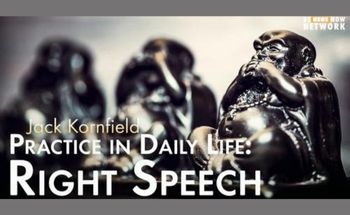Little fears cause anxiety, and big fears cause panic.— Chuang Tzu
Although most of us have been deeply conditioned by fear, for the most part we have avoided directly exploring its nature. Because we are not aware of its workings, it is often an unconscious driving force in our lives. When fear arises, whether it’s fear of pain, fear of certain emotions, or fear of death, the meditation practice of mindful loving awareness invites us to explore and understand fear itself. What does it feel like? What are the sensations in the body? Where are they located? Are there images or pictures in the mind? We can look closely to see the constellation of experiences we call fear, to understand its true nature. When we do so we see that fear is also a passing conditioned experience, and then it becomes much more workable.
Start simply. When fear arises, name it softly and experience what it does to the breath, to the body, how it affects the heart. Notice how long it lasts. Be aware of the images. Notice the sensations and ideas that accompany it, the scary stories it tells. Fear is often an anticipation of the future, an imagination, often unfounded. As Mark Twain remarked, “My life has been filled with terrible misfortunes—most of which never happened.”
Of course, when we work with the fearful mind, we will initially become afraid. However, at some point, if we open our eyes and our heart to the fearful mind and gently name it, “fear, fear, fear,” experiencing its energy as it moves through us, the whole sense of fear will shift and eventually become recognition: “Oh, fear, here you are again. I know you. How interesting that you’ve come.” Make friends with your fear.
From this foundation of loving awareness and acceptance we can make choices about how to act with some degree of discriminating wisdom. Sometimes it is wise to retreat from a situation, and sometimes we move ahead despite the fear. We become more willing to take some risks because our energy is not so bound up in resisting the feeling of fear itself. We learn that it is okay to feel fear. Our mindfulness practice should challenge us to come to the edge of what we’re willing to be with, what we’re willing to do, what we’re willing to open to. If we keep avoiding the feeling of fear, then we have to build barriers and defenses, closing ourselves off from every experience where fear might arise. Not only is this impossible to do, but it results in a narrow and restricted way of living. We close our hearts and close off the possibility of true vitality, compassion and growth.
Practicing meditation with patience and courage, we can gradually learn trust, how to sit firmly on the earth and kindly sense the contraction and trembling of our body without running away. We learn how to feel the floods of strong emotions—fear, grief, and rage—and to allow them to slowly release with mindfulness. We learn to see the endless mental stories that repeat over and over, and with the resources of mindfulness and compassion, to let them go and relax, to steady the mind and return to the present. Befriending fear becomes a gateway to freedom, an invitation to live more fully with trust and love.
Practice: Transforming Difficult Emotions
Visit the Pandemic Resources page on my website for meditations & other materials.






